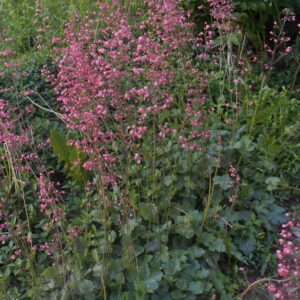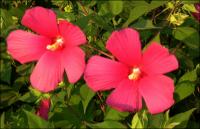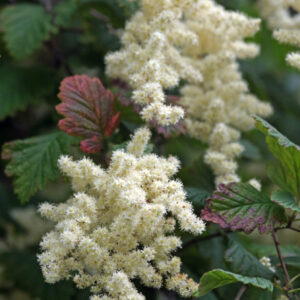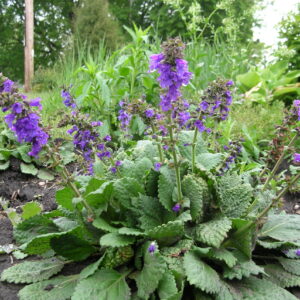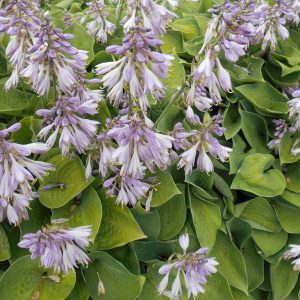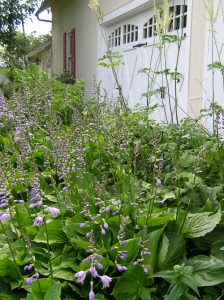Perennials & Biennials
Showing 249–256 of 511 results
-
Heuchera x brixoides ‘Caldwell’ Z 4-8
Small pink bells surround top 6” of the wiry, erect stems in late spring-mid-early-summer.
Small pink bells surround top 6” of the wiry, erect stems in late spring-mid-early-summer.
Size: 12-18” x 6-8”
Care: part shade in moist to moist well-drained soilI do not know which Heuchera this is. This was growing here when we moved here around 1995. We bought the property from spry 93-year-old Anne Patterson, “for sale by owner.” I cannot imagine that she was buying new plants in her 90’s so I’m making an educated guess that it is at least 40 years old. It does not set seed, not unusual for a hybrid. But we like it so much that we’ve divided it several times over the last couple of years to make enough to sell. Try as I might, I cannot identify it but I’ve narrowed it down to a hybrid called brixoides, of which there are innumerable different selections. I’ve named it ‘Caldwell” for the crossroads where our nursery is located, originally named for the 1st settlers, Joseph and Sara Caldwell c. 1860.
-
Hibiscus moscheutos Rose mallow Z 5-9
August and September, bodacious, white, pink or crimson platters, looking like the tropics.
August and September, bodacious, white, pink or crimson platters, looking like the tropics.
Size: 5-8' x 3'
Care: Sun, moist to moist well-drained soil, no staking needed.
Native: Southern U.S.
Wildlife Value: Attracts butterflies esp. Cloudless Sulphur butterflies relish Rose mallow’s nectar.One Native American tribe used this plant to cure inflamed bladders. 1st collected by Rev. John Banister (1649-1692) who moved to colonial Virginia in 1678. A gunman mistakenly shot and killed him while he collected plants. Cultivated by Lady Skipworth in her colonial Virginia garden. Bloomed for Jefferson in July, 1767. Grown at America’s 1st botanic garden, Elgin Botanic Garden 1811.
-
Holodiscus discolor Creambush, Ocean spray Z 5-10
Multistemmed shrub with dense, elegant pyramidal clusters of arching cream-colored flowers in early to mid summer. Leaves tint red in fall.
Multi-stemmed shrub with dense, elegant pyramidal clusters of arching cream-colored flowers in early to mid summer. Leaves tint red in fall.
Size: 4-8’ x 8’
Care: sun to part shade in moist to moist well-drained soil
Native: Montana to Colorado west to the Pacific.
Wildlife Value: nectar for hummingbirds, food for butterfly caterpillars, bird habitat.Hard and durable wood was used to make digging sticks, spears, harpoon shafts, bows, and arrows by nearly all coastal Native groups. A few used the wood to make sticks to barbeque salmon, fish hooks, needles for weaving and knitting, Pegs were made to use like nails. Others made wood intoarmor plating and canoe paddles.
A few Natives made an infusion of boiled fruit to cure diarrhea, measles, chickenpox and as a blood tonic. Collected by Meriwether Lewis in today’s Idaho on the Clearwater River, May 29, 1806 en route back east on the Lewis and Clark Expedition.**LISTED AS OUT OF STOCK BECAUSE WE DO NOT SHIP THIS ITEM. IT IS AVAILABLE FOR PURCHASE AT OUR RETAIL LOCATION.
-
Horminum pyrenaicum Dragonmouth, Pyrenean Dead-nettle Z 5-9
Deep purple salvia-like blooms in April to May above rosettes of wide, flat leaves
Deep purple salvia-like blooms late spring to early summer above rosettes of wide, flat leaves
Size: 8-16” x 12”
Care: Sun to part shade in moist well-drained soil. Drought tolerant.
Native: Pyrenees & Alps
Wildlife Value: Attracts bees, butterflies and birds. Deer and rabbit resistant.Before 1753, Linnaeus.
-
Hosta ‘Blue Cadet’
Lavender flowers late in season
Lavender flowers late in season
Size: 35-40” x 36”
Care: part to full shade in moist well-drained soil
Awards: Nancy Minks Award in 1986Hosta was named for Dr. Nicholas Host (1761 – 1834) the physician to the emperor of Austria and an expert on grasses. This cultivar ranked as one of the top 7 hostas and one of the top 2 hostas with blue foliage. Hybridized by Aden in 1974.
-
Hosta ‘fortunei ‘Aureomarginata’ Z 3-9
One of the most popular Hosta varieties. Handsome, broad, ribbed, wavy, green foliage with yellow margins. Lavender, trumpet-shaped flowers rise on scapes above the leaves in summer.
One of the most popular Hosta varieties. Handsome, broad, ribbed, wavy, green foliage with yellow margins. Lavender, trumpet-shaped flowers rise on scapes above the leaves in summer.
Size: 12-16” x 18-24”
Care: shade to part-shade in moist well-drained soil. Tolerant Black walnut toxinsHosta named for Austrian botanist Nicholas Thomas Host (1761-1834) in 1812. This variety registered in 1987.
-
Hosta lancifolia Lanceleaf Hosta Z 3-8
Lavender flowers in late summer to early autumn
Lavender flowers in late summer to early autumn
Size: 18" x 30"
Care: sun to shade in moist well-drained soil.
Native: Japan
Wildlife Value: attracts hummingbirdsJapanese called Hostas Giboshi and ate young leaves in spring as a vegetable. Hosta was named for Dr. Nicholas Host (1761-1834) the physician to the emperor of Austria. Hostas, cultivated since at least the 12th century in Asia, were first described for Europeans by Englebert Kaempfer in 1712, doctor for the Dutch East Indian Company on Dechima Island. . He taught Japanese interpreters astronomy and math and plied them with liquor in exchange for plants. H. lancifolia drawings date to 1690. Cultivated in the U.S. since the late 1800’s.
-
Hosta ventricosa Z 3-8
rich lavender bells periscope over heart-shaped leaves
In late summer rich lavender bells periscope over heart-shaped, prominently veined foliage.
Can not ship to: Maryland
Size: 20" x 36"
Care: Part shade in moist to moist well-drained soil. Tolerate Walnut toxicity
Native: China
Wildlife Value: attracts hummingbirds
Awards: Received England's Royal Horticultural Society Award of Merit.Japanese called Hostas Giboshi and ate young leaves in spring as a vegetable Hosta was named for Dr. Nicholas Host (1761-1834) the physician to the emperor of Austria. Hostas, cultivated since at least the 12th century in East Asia. Empress Josephine grew this at Malmaison. Redoute, Josephine’s botanical illustrator, painted H. ventricosa in 1805.

